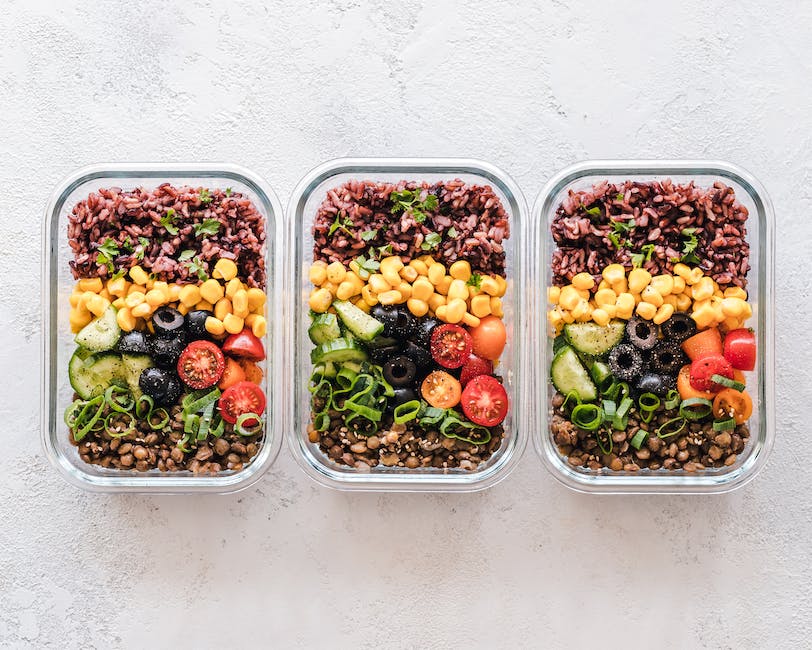Making the Most of Your Meals: Time-Restricted Diet Plan
Nourishing your body with the right amount of food is essential to maintain a healthy lifestyle. But, for many of us, it can be intimidating to figure out the best way to do so. One step in the right direction is to create a tailored meal plan that takes into account both your nutritional needs and the time you have to prepare and eat your meals. With that in mind, this article serves as an introduction to making the most of your meals with a time-restricted diet plan!
1. Unlocking Potential with Time-Restricted Dieting
Time-restricted dieting offers a powerful method of releasing your body’s potential and helping you to reach your health and fitness goals. By limiting caloric intake to certain window of time, the body is able to start burning fat and replenishing nutrient levels more efficiently.
- Metabolism: Eliminating certain types of food and meals throughout the day can balance your metabolism and shift your body to burn fat as the primary energy source.
- Weight Loss: Reducing your calorie intake can help with fat loss, as well as reducing overall body weight. Time-restricted dieting helps ensure you are eating the right types of foods, and not overconsuming calories.
- Physical & Mental Performance: Numerous studies have noted improvements to physical and mental performance when eating within certain times of the day. This may include improved focus, energy levels and recovery.
Time-restricted dieting is also great for simplifying meals, and can help to save time and energy that would usually be spent preparing and cooking meals. When done correctly, time-restricted dieting can be the perfect road to unlocking the body’s potential for better health and performance.

2. Crafting a Delicious Eating Plan
Eating well means crafting an eating plan that is both delicious and nutritious. To get started, focus on what types of flavors and cuisines you enjoy and that make you feel good.
Whole Foods Are the Base
- Include plenty of plant-based proteins and complex carbs.
- Focus on fresh fruits and vegetables that are in season.
- Supplement with nuts, seeds, legumes, grains, and other nutritious, low-fat foods.
Once you have your whole food foundation, add your own twist. Think toppings, sauce combinations, herbs and spices, and even fermented toppings like raw sauerkraut or kimchi. These combinations make adding new flavors to your recipes an exciting and delicious way to enjoy nutritious and balanced meals. Plus, you may even find some new flavors you never knew you had a taste for.
3. Maximizing Life Through Time-Conscious Meals
Spending a lot of time in the kitchen preparing meals is a reality for most of us. But with a few time-saving strategies, you can maximize your life and manage your time more efficiently. Here are three ways to maximize your meal times.
- Choose Convenient and Nutritious Meals: Whether you’re whipping up your own meal or ordering takeout, choose something nutritious. Make sure the meals provide your body with all the necessary nutrients while also being convenient and quick to make. Pre-packaged meals are an excellent option if you’re short on time.
- Simplify Your Grocery List: Consider how much time you spend at the grocery store. Adjust your list and focus on buying items you already know how to make. Also, it’s a good idea to buy ingredients in bulk when possible. That way, you’ll have enough for multiple meals, and you won’t have to go out for supplies.
- Create a Meal Plan: Designing a meal plan in advance can help to speed up food preparation. Choose your meals for the week ahead, taking the time to make sure they’re balanced and nutritious. This will help you easily transition from one dish to the next. And knowing what you’ll be making during the week reduces the time you need to spend deciding what to cook.
4. Get the Most Out of Your Day with a Time-Restricted Diet
Time-Restricted Diet (TRD) is an approach to eating where meals are consumed only within a short set period of time each day. By limiting when you can eat, it helps you to get the most out of your days, by focusing on your physical, mental and emotional health. Here are four tips to make the most of your TRD approach:
- Keep it short: TRD is designed to reduce the total number of hours during which you consume food. Depending on your goals, that could be as little as 6-8 hours or up to 12 hours.
- Plan ahead: Decide what hours you’re going to eat and then plan for that. That way, you’ll know what your schedule looks like and can plan accordingly.
- Mix it up: Don’t stick to the same routine each day. Experimenting with different meal times can keep things interesting. You might find that you have more energy or perform better when eating between certain times.
- Stay focused: Don’t snack during the times you’re not supposed to be eating, no matter how tempting it may be. Swapping excessive snacking for healthy meals can be a great way to keep your energy levels high and body nourished.
Time-restricted diet isn’t about deprivation or restriction; it’s about maximising your energy and taking control of your eating habits. Setting time constraints encourages better focus, simplifies decision making and fosters improved discipline. Experiment with this method and discover which approach works best for you.
5. Unlocking the Secret to Time-Restricted Dieting Success
Time-restricted dieting is an increasingly popular way to manage your weight because of its convenience and flexibility. But even with all its advantages, it can take a bit of effort to get it just right. Here are five tips for unlocking the secret to success when it comes to time-restricted dieting:
- Establish a Eating Window – First, you need to set a hard start and finish time for when you are allowed to eat. If you set a 12-hour window between 8am and 8 pm and stick to it, you give your body plenty of time to process the food and burn off calories.
- Drink Plenty of Water – Water is essential to feel fuller and sleep better, which is critical for weight management. Make sure you are drinking at least 8 glasses of water a day to keep your energy levels up despite your limited eating window.
- Plan Meals Ahead of Time – Meal planning helps you maximize the time you have to eat. This way, you will have healthy meals prepared for each day within your eating window, and will avoid unhealthy choices due to being unprepared.
- Stay Active – If you pair time-restricted dieting with regular exercise, you can burn even more calories and become stronger. Exercise also helps to reduce stress, which can often cause cravings.
- Don’t Forget to Rest – Finally, make sure to give your body time to rest and recover from all the hard work you have been doing. Get plenty of sleep at night and allow yourself to have at least one rest day per week.
With these five tips, you are sure to succeed in your time-restricted dieting plan. Your weight management goals will be within reach when you follow a consistent plan, use meal planning to your advantage, and make sure to fuel your body with the energy it needs.
Asked Questions
Q: What is a time-restricted diet plan?
A: A time-restricted diet plan is a type of eating regimen where you have designated eating and fasting periods throughout the day. The idea is to focus on nutritious, whole-foods, while managing portion size and sticking to a set eating window.
Q: What are the benefits of a time-restricted diet?
A: A time-restricted diet can have a variety of benefits to your health, from improved metabolic health to improved weight management. Additionally, it can help minimize cravings and reduce your overall calorie intake.
Q: How do I get started with a time-restricted diet?
A: A good place to start is by planning ahead and learning which foods are nutritious and provide the nutrients your body needs. Choose meals that are rich in fiber, vegetables, and healthy fats like avocado, nuts, or fish. Additionally, look into apps and online tools to help track your meals and manage your set window of eating.
Q: Are there any potential risks associated with a time-restricted diet?
A: There are potential risks associated with this diet as with any other, however if followed properly the overall benefits can outweigh any potential risks. Be sure to check in with your doctor prior to beginning any new diet regimen.
Following this diet plan isn’t necessarily easy, but with a little patience and dedication, you’ll find yourself doing a lot more with the time you have, and get the most out of each and every meal. Optimize your health and energy while giving yourself quality time—it’s a win-win!


